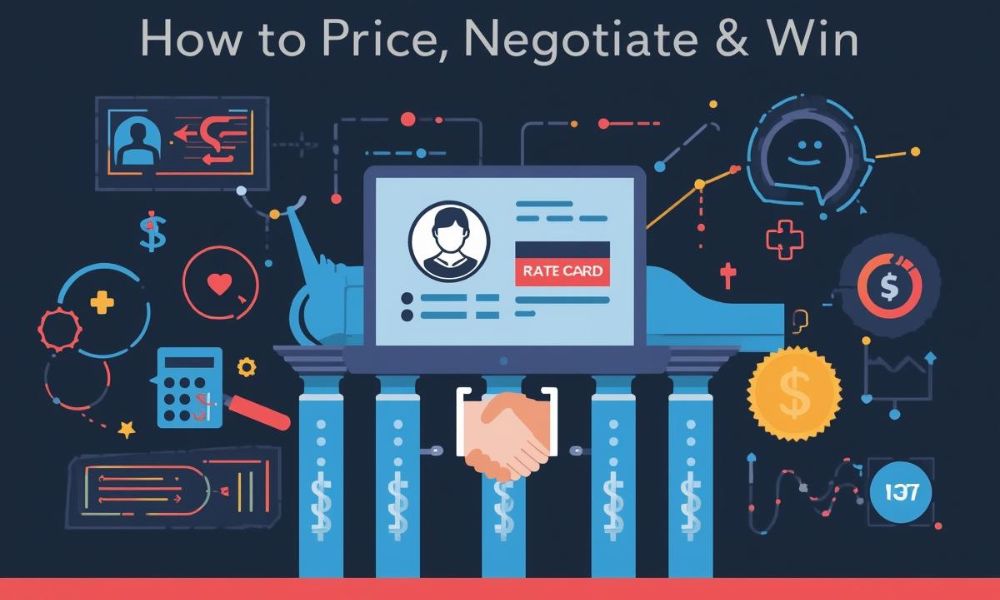
Pricing in influencer marketing has never been more complex, or more important to get right. The days of calculating value by follower count are gone. Today, real pricing depends on verified performance, content quality, and measurable business outcomes.
We’ve seen both creators and brands struggle to find that balance. Influencers risk undervaluing their time and reach, while marketers often pay inflated rates based on vanity metrics. The result is inconsistent ROI and partnerships that fail to reach their full potential.
That’s where a structured influencer rate card comes in. It’s more than a pricing sheet, it’s a framework that brings clarity, accountability, and trust to every collaboration.
This article outlines a clear framework for building influencer rate cards that reflect measurable value. You’ll find the five pillars that shape modern pricing, examples of high-performing templates, and proven strategies for negotiating rates that balance fairness, performance, and long-term collaboration.
The Rate Card Reckoning: Why “Cost-Per-Follower” Is Dead
The pricing model built on follower count doesn’t work anymore. What once served as a simple benchmark for reach now misrepresents real influence. Followers can be inactive, unengaged, or even purchased, making the cost-per-follower metric increasingly irrelevant in modern influencer marketing.
We’ve seen that a creator’s true value lies in measurable business impact, not raw numbers. A smaller, engaged audience often drives more meaningful results than a massive following that doesn’t convert. Modern rate cards must reflect this shift, prioritizing verified engagement, authentic connection, and long-term brand lift over vanity metrics.
The Value Shift – From Vanity Metrics to Real Business Outcomes:
Influencer marketing has matured into a performance discipline. Engagement rates, click-throughs, conversions, and audience retention now tell the real story of value.
When building an influencer rate card, creators should benchmark pricing around data-driven outcomes, not estimated reach. Brands no longer pay for potential exposure, they invest in measurable results. Metrics such as content saves, repeat campaign performance, and post-campaign brand recall are better indicators of actual influence.
This value shift means creators who understand their analytics and communicate them clearly gain leverage. Rate cards built on performance metrics signal professionalism, helping both sides align on expectations and ROI.
Case Study – The Nano-Influencer Who Outperforms a Mega-Influencer (and Why):
A campaign we reviewed for a mid-sized skincare brand illustrated this perfectly. One nano-influencer with 12,000 followers generated 8% engagement and a 6% click-through rate on tracked links, producing more sales per post than a macro-influencer with 800,000 followers, who delivered under 1% engagement and negligible conversions.
The smaller creator’s audience trusted her recommendations and interacted authentically. Her rate card reflected that credibility, not her follower count.
This pattern repeats across industries. Engagement, content quality, and audience alignment consistently outperform scale alone. The smartest pricing models in 2025 recognize that influence isn’t about who reaches the most people, it’s about who moves them to act.
What Is an Influencer Rate Card (and Why It Matters)
An influencer rate card is a structured pricing document that outlines how much a creator charges for specific deliverables across different platforms. It usually includes rates for content types such as posts, stories, videos, or bundles, along with any add-ons like exclusivity, licensing, or usage rights.
At its core, a rate card brings transparency to influencer partnerships. It helps creators communicate their value clearly and ensures brands understand exactly what they’re paying for. For creators, it prevents underpricing or inconsistent deals. For brands, it simplifies budgeting, forecasting, and campaign comparison across multiple influencers.
Rate cards can take different formats depending on how formal or automated the collaboration process is. Some creators use PDF or Google Sheet versions integrated into their media kits, while others use dashboards or digital rate card features provided by some influencer platforms (for example, Hypefy offers automated pricing and campaign workflows that may support dynamic pricing views).
Whatever the format, the goal remains the same: clarity. A strong rate card replaces guesswork with data, speeds up negotiation, and helps both sides focus on what matters most: performance and partnership quality.

Deconstructing Your Value: The 5 Pillars of Smart Pricing
A well-designed influencer rate card goes beyond listing prices. It reflects the true drivers of value, the measurable elements that shape what a partnership is worth. We call these the five pillars of smart pricing. Together, they form a framework for setting rates that align with performance, effort, and long-term brand impact.
Pillar 1: Audience & Reach (The Foundation)
Your audience is the foundation of your pricing model, but not all audiences carry the same value.
Why is engagement rate the king metric?
Engagement rate is the clearest indicator of real influence. It measures how actively followers interact with your content through likes, comments, shares, saves, or clicks. A 4% engagement rate on 10,000 followers delivers more meaningful reach than 1% on 100,000.
When building an influencer rate card, engagement data should be front and center. Brands use it to predict campaign performance, while creators use it to justify their pricing. A consistent engagement rate signals trust and authenticity, qualities that convert views into measurable results.
The power of niche: Why 10K targeted followers beat 100K generic ones?
Niche relevance is one of the strongest pricing multipliers. A smaller, highly focused community often drives better ROI than a broad but disengaged audience.
For example:
- A beauty creator specializing in vegan skincare builds trust with conscious consumers who convert quickly.
- A tech micro-influencer offering honest product breakdowns influences high-intent buyers.
- A B2B LinkedIn creator may have fewer followers but delivers precise reach to decision-makers.
In each case, the creator’s audience quality outweighs size. Rate cards that factor in audience alignment, not just volume, help position pricing as value-based rather than number-based.
Pillar 2: Content Creation Cost (Your Time & Talent)
While audience data defines influence, your time and creative input determine production value, and both must be reflected in your rate card. High-performing content doesn’t happen instantly; it involves planning, execution, and refinement that go far beyond a single post.
The hidden hours: ideation, shooting, editing, project management
Behind every polished reel or carousel lies a significant amount of unseen work. Concept development, scripting, location setup, lighting, and editing all take time. Add revisions, brand approvals, and scheduling, and a single deliverable can represent several hours, or even days of effort.
When influencers don’t account for these hidden hours, they undervalue their work and set unsustainable expectations for future collaborations. Including creative labor in your rate card ensures fair pay and communicates professionalism to brands.
The “equipment & software” factor – how overhead shapes pricing?
Production tools carry real costs. Cameras, microphones, lighting kits, editing software, and storage platforms all contribute to content quality. These expenses are part of the business and should influence your base rate.
For instance, a creator producing high-resolution, well-edited video content with professional gear should charge more than one delivering quick smartphone clips. Quality content elevates brand image and campaign performance, your rate card should make that value visible.
Pillar 3: Usage & Licensing (The Critical Multiplier)
Usage rights and licensing terms are some of the most overlooked, yet most valuable, elements of influencer pricing. When brands pay for content, they’re not only compensating for creation but also for how and where that content will be used.
Why do brand usage rights change the price entirely?
If a brand wants to republish your content on their own channels, feature it in ads, or run paid campaigns using your likeness, that requires additional fees. The value of your work extends beyond the initial post, it becomes part of the brand’s marketing asset library.
We recommend defining usage terms directly within your rate card. Outline whether the price includes organic reposts, paid ad rights, or time-limited licensing. The clearer these terms are, the fewer disputes or renegotiations will occur later.
The licensing surcharge – how to charge for extended rights?
Licensing should scale with exposure and duration. A three-month paid usage agreement, for example, might add 25–40% to your base rate, while a one-year license could double it. Global ad usage or full buyouts should command the highest premiums, since they limit your ability to work with competitors.
For creators, this distinction is critical: you’re not just selling content, you’re licensing intellectual property. Rate cards that clearly separate creation costs from licensing fees signal professionalism and protect long-term earning potential.
Pillar 4: Platform & Format (The Content Matrix)
Not every platform or content type carries the same value. Each requires a different level of effort, production quality, and audience engagement potential — and your rate card should reflect that. Understanding how platforms and formats affect pricing helps creators charge fairly and helps brands evaluate campaign costs accurately.
The TikTok vs. Instagram vs. YouTube pricing divide:
Short-form content dominates attention spans, but each platform rewards creators differently.
- TikTok prioritizes virality, often offering faster reach but shorter shelf life.
- Instagram focuses on visual branding and ongoing audience connection.
- YouTube delivers depth, evergreen visibility, and long-term search traffic.
A 30-second TikTok might generate quick engagement, while a YouTube integration continues driving conversions months after upload. That longevity means higher pricing. Rate cards should price content proportionally to platform impact and lifespan.
Why does a reel cost more than a story, and a video more than a static post?
Effort and exposure determine value. A single photo post requires minimal editing and limited distribution, whereas a reel or video involves concepting, filming, editing, and higher production quality.
Stories, though quick to create, have a 24-hour lifespan and therefore lower long-term value. Videos, on the other hand, deliver persistent visibility and better engagement metrics. Reflecting these distinctions in your rate card ensures transparent communication about what each deliverable is worth.
By aligning pricing with format complexity and platform potential, creators demonstrate a professional understanding of value, and brands can make informed investment decisions based on results, not assumptions.
Pillar 5: Exclusivity & Partnership Duration (The Relationship Premium)
Exclusivity and duration are often the deciding factors between a one-time collaboration and a long-term partnership. Both directly impact how much freedom a creator has to work with other brands, which means they should always influence pricing.
The retainer model – how to price long-term ambassadorships?
When brands want ongoing collaborations, the relationship shifts from transactional to strategic. A retainer or ambassador agreement typically involves multiple deliverables spread over several months, consistent posting, and brand alignment in public communications.
Instead of charging a flat per-post rate, creators should calculate the total projected workload, time commitment, and opportunity cost. Long-term partnerships provide stability but also require consistent creative output and brand compliance. A discounted monthly rate can make sense if it guarantees steady work, but it should still reflect the sustained effort required.
The exclusivity clause – when to charge a premium?
Exclusivity limits a creator’s ability to collaborate with competitors, reducing potential income. That restriction must be compensated accordingly. The more restrictive the clause by industry, geography, or duration, the higher the premium.
For example, a three-month exclusivity agreement within a single product category might add 20–30% to a campaign rate, while full-industry exclusivity for a year could double it. Every influencer rate card should outline how exclusivity is priced to avoid misunderstandings and ensure fair value exchange.
By including clear terms for exclusivity and partnership length, creators protect their earning potential and brands gain clarity on what level of commitment their budget truly buys.

The Anatomy of a High-Converting Rate Card (With Template)
A strong influencer rate card doesn’t just display prices, it communicates value, builds trust, and streamlines decision-making. Whether it’s a one-page PDF, a section within your media kit, or a shared Google Sheet, clarity and structure matter more than design.
The one-pager rule: clarity and brevity are key
Your rate card should give brands everything they need to make a quick, confident decision. Keep it short, easy to scan, and visually clean. One page is ideal, two at most if you include visuals or audience data.
Each section should highlight what you offer, how much it costs, and what makes your work worth the investment. Avoid cluttered layouts, unnecessary detail, or inconsistent pricing, simplicity builds credibility.
Your must-have sections
1) The hero statement: one-sentence summary of your value proposition. Start with a clear positioning line that tells brands who you are, what niche you serve, and what outcome you deliver.
Example: Lifestyle creator helping eco-conscious audiences discover sustainable beauty and wellness brands.
2) The service menu: table of deliverables and pricing. Include a clear, itemized list of offerings and rates. This table helps brands forecast budgets and compare deliverables easily.
| Platform | Deliverable | Description | Rate | Notes |
| Feed post + story | 1 static post + 3 stories | $500 | 30-day usage rights | |
| TikTok | Video (30 sec) | 1 creative video | $750 | Includes organic reposting |
| YouTube | Product integration | 1 video mention | $1,200 | 6-month paid usage |
| Bundle | Instagram + TikTok | 2 posts + 2 stories | $1,100 | Multi-platform discount |
This table can also include engagement averages or audience data to provide performance context.
3) The “why me” section: key metrics, demographics, and social proof. Add a compact summary of metrics that matter: engagement rate, reach, audience age and location breakdown, and past brand collaborations. Visual cues like icons or mini-graphs make this data easy to digest and add professional polish.
4) Terms & conditions: payment, revisions, and content ownership. Outline payment terms (e.g., 50% upfront, 50% on completion), revision limits, and ownership rights. Clear terms eliminate confusion and protect both parties.
Tip: Consider attaching this section as a standardized note at the end of every proposal or email. It signals professionalism and helps prevent negotiation friction later.
A high-performing rate card combines transparency and confidence. It positions creators as organized partners, not freelancers guessing their worth, and gives brands the structure they need to budget and decide quickly.
How Brands Use Influencer Rate Cards to Budget Smarter?
Influencer rate cards aren’t only tools for creators, they’re essential for brands building efficient, data-driven marketing budgets. A transparent pricing structure allows marketers to forecast costs accurately, compare creators objectively, and measure ROI across campaigns.
1) Analyzing rate cards to compare ROI across tiers
By reviewing multiple rate cards, brands can benchmark performance and pricing across influencer tiers. For example, a nano-influencer charging $200 per post with 8% engagement may deliver a lower cost per engagement than a macro-influencer charging $3,000 at 1.5% engagement. This kind of comparison helps identify the sweet spot between reach, cost, and performance, not just visibility.
2) Using rate cards for forecasting, negotiation, and reporting
Rate cards simplify campaign planning. When creators share consistent pricing formats, marketers can estimate total spend quickly, allocate budgets across channels, and build performance projections before a single post goes live. During negotiation, rate cards act as transparent baselines that make conversations more objective. Post-campaign, they help evaluate whether actual results aligned with predicted ROI.
Why brands benefit from transparent creator pricing?
Transparency builds trust and shortens the path to collaboration. Brands that work with creators who provide structured rate cards experience fewer miscommunications, faster approvals, and more predictable results.
Platforms like Hypefy help centralize this process by offering built-in campaign pricing views, influencer metrics, and performance comparisons, enabling brands to make faster, evidence-based decisions about where to invest.
In short, rate cards make influencer marketing measurable. They turn subjective discussions about “value” into data-driven budgeting decisions that optimize every dollar spent.

Negotiation Field Guide: How to Present Your Rates and Stand Your Ground
Even the best rate card is only as effective as the way it’s presented. Negotiation is a natural part of every influencer collaboration, and how you handle it defines not only the deal you close today but also the kind of partnerships you attract in the future. The goal is balance, flexibility without compromise, confidence without rigidity.
A) The “we have a lower budget” response – pivot, don’t panic:
When brands respond with a smaller budget, it doesn’t always mean the deal is lost. In most cases, it’s an opening to adjust the scope rather than the value.
If a brand can’t meet your full rate, offer a scaled-down deliverable, fewer posts, shorter content, or limited usage rights. This keeps the collaboration accessible while preserving your baseline worth. Another approach is to bundle services across platforms, offering a slight discount for multi-channel exposure instead of a direct rate cut.
This approach reframes negotiation from price reduction to value optimization, maintaining professionalism and ensuring both sides benefit.
B) The power of “no” – when to walk away from a bad deal:
Saying no can be one of the most strategic moves a creator makes. Accepting undervalued deals sets a precedent that’s hard to reverse and signals to future partners that your pricing is flexible.
Creators who consistently hold their ground tend to attract brands that respect their expertise and budget accordingly. Turning down the wrong opportunity opens space for the right ones, partnerships aligned with your niche, creative standards, and professional goals.
In the long term, protecting your rate integrity preserves not just earnings but brand positioning.
C) The value-add conversation, trading rate for product, experience, or licensing:
Sometimes flexibility can work in your favor, especially when brands can offer something beyond monetary payment. If a brand provides premium products, exclusive event access, or extended licensing opportunities, you can factor those benefits into your total compensation.
The key is to assign tangible value to non-cash perks. A $300 skincare package or paid travel experience can offset part of your rate if it aligns with your content goals or audience interests.
For brands, this opens creative collaboration routes beyond fixed pricing. For creators, it’s a way to diversify compensation without lowering perceived value.
The strongest partnerships happen when both sides leave the table with equal satisfaction, measurable value, mutual respect, and clear expectations.
The Future-Proof Creator: Adapting Your Rate Card for 2025 and Beyond
Influencer pricing is no longer static. As content formats evolve, algorithms shift, and AI tools reshape production, rate cards must evolve with them. Staying competitive means updating pricing not only to reflect your work today but also to anticipate how the industry will measure value tomorrow.
The rise of AI – should you charge more or less for AI-assisted content?
AI has become a standard part of the creator toolkit, from video editing automation to script generation and analytics. The question isn’t whether to use it, but how it impacts pricing.
When AI tools speed up workflow or enhance quality, the output often justifies the same or even higher rates. Brands pay for creative direction and authenticity, not the time saved. However, if AI replaces significant manual labor (like editing or caption writing), it may reduce production costs, creating space for new pricing models.
We recommend addressing AI use transparently in proposals and rate cards. State which parts of your process are AI-supported and how that affects turnaround time or quality. Transparency builds trust and reinforces your value as a strategic partner, not just a content producer.
Bundling and unbundling – creating custom packages for the modern brand.
One-size-fits-all pricing is fading. As campaigns become more integrated across platforms, both creators and brands benefit from modular pricing structures.
Bundling allows you to offer multi-platform packages, for example: one reel, one TikTok, and a story sequence, at a combined rate that delivers more value per dollar. Unbundling, on the other hand, helps brands pay only for what they need, streamlining smaller campaigns or testing partnerships before scaling.
A flexible rate card that supports both approaches shows adaptability and professionalism. It lets creators respond to changing demand, while giving brands transparency to plan smarter and invest confidently.
The creators who thrive in 2025 will be those who treat pricing as strategy, adjusting not just for effort or audience size, but for innovation, insight, and long-term brand alignment.

Key Takeaway: Transparent Pricing Builds Sustainable Partnerships
Transparent pricing is more than an operational detail, it’s the foundation of trust between creators and brands. A clear, structured rate card ensures both sides understand the value being exchanged and eliminates the uncertainty that slows down collaboration.
Creators who define their rates around data, effort, and outcomes communicate professionalism and confidence. Brands that evaluate those rates objectively build stronger, longer-lasting partnerships rooted in fairness and accountability.
At Hypefy, we make this process easier by connecting verified performance metrics, campaign analytics, and pricing benchmarks in one place. The result is a faster, more transparent way to identify real value and invest in creators who deliver measurable impact.
In the end, the strongest partnerships aren’t built on guesswork, they’re built on clarity, consistency, and shared results.
Related Articles to Read
If you found this guide on influencer rate cards useful, explore these related resources to strengthen your pricing, contracting, and collaboration strategies:



